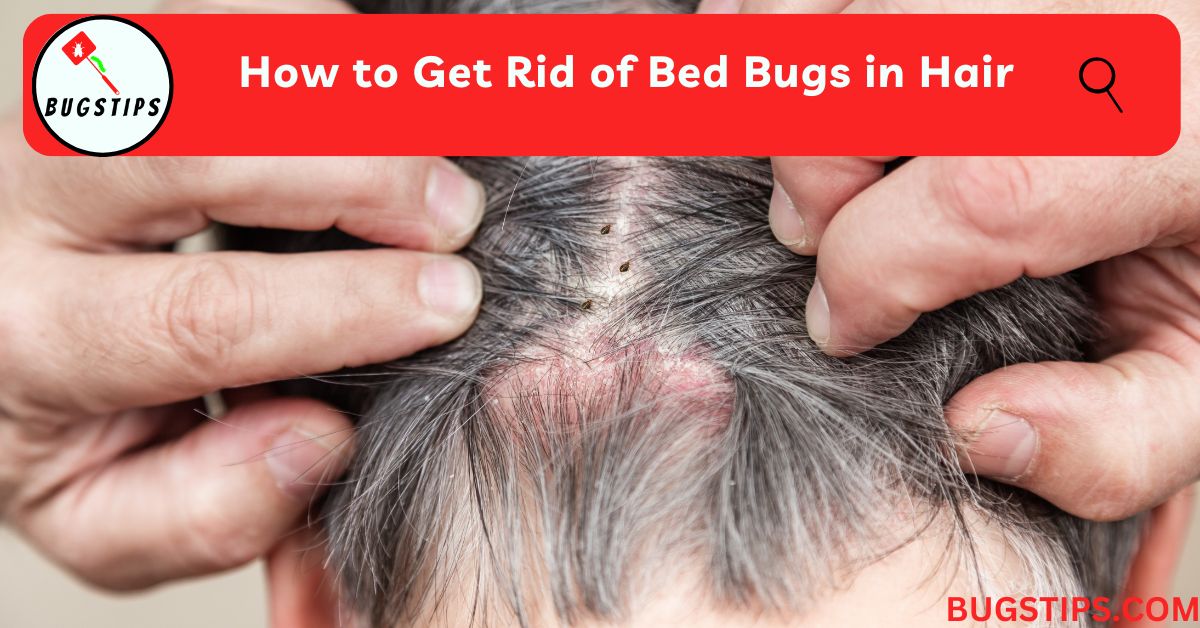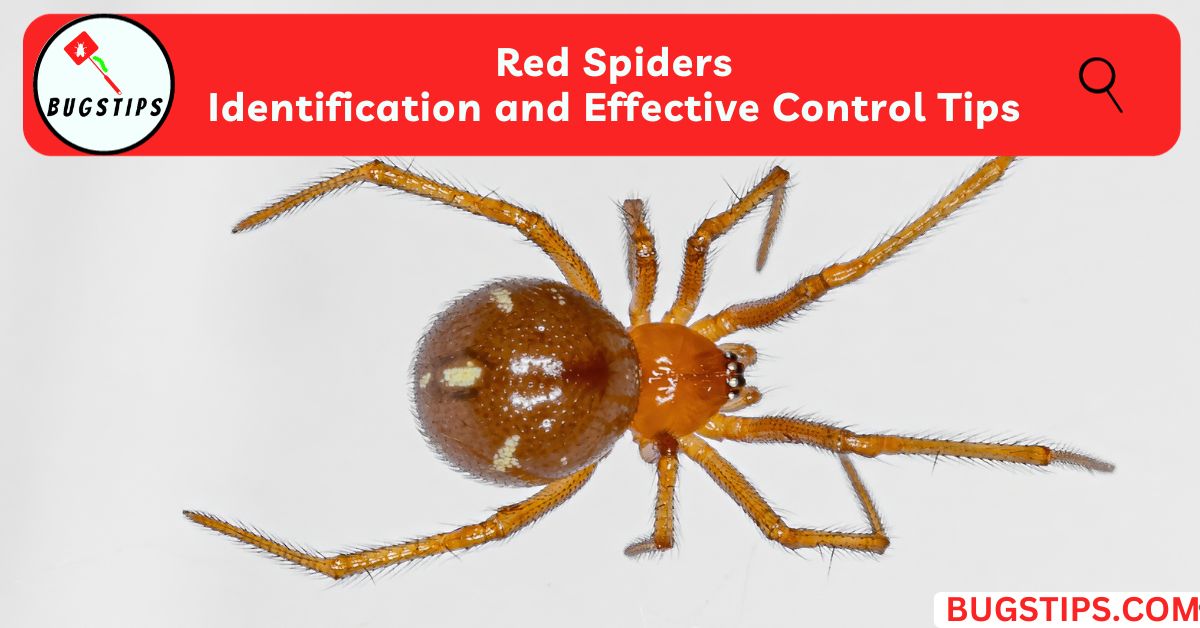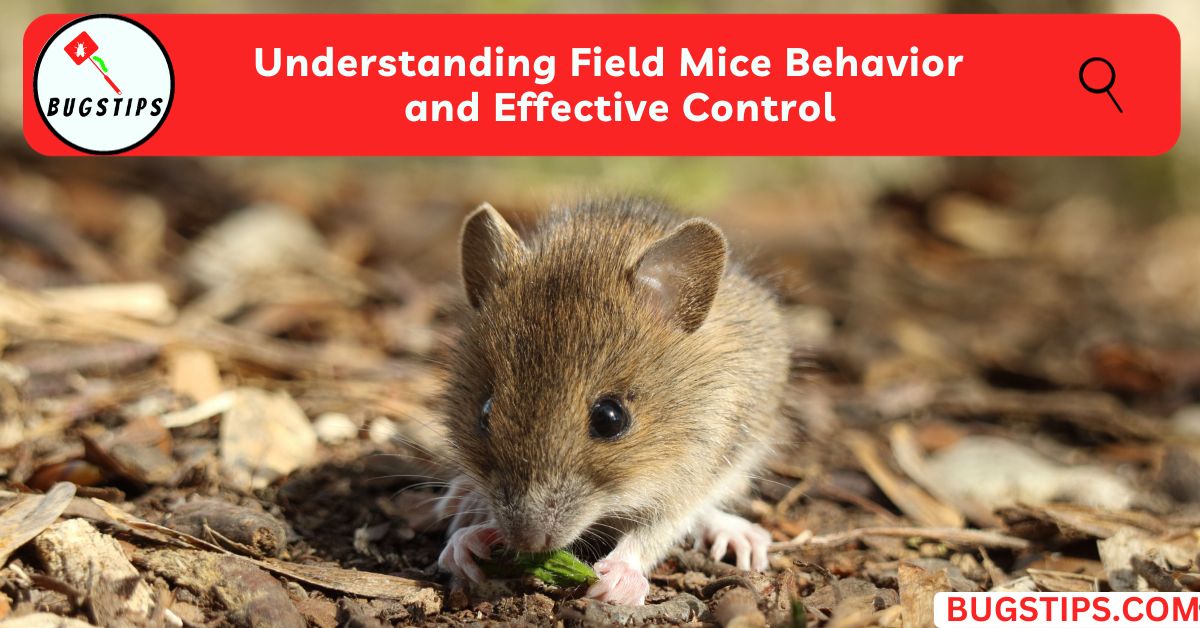This post may contain affiliate links which means as an Amazon Associate, this site may earn a small commission on qualified purchases made through links at no extra cost to you. Learn more on Affiliate Disclosure
Crane flies, commonly known as mosquito eaters, are delicate insects resembling giant mosquitoes And Crane flies are a common sight in lawns and homes, especially during the spring and summer months.
While these long-legged insects may seem harmless, their presence can be a nuisance and even cause damage to lawns. If you want to know how to get rid of crane flies, well this article is for you.
In this article, we’ll cover the various methods and products that can be used to eliminate crane flies, as well as preventative measures that can be taken to keep them at bay.
By following these steps, you can successfully get rid of those pesky crane flies and prevent them from coming back.
What Are Crane Flies?
Crane flies, also known as mosquito eaters or daddy longlegs, are insects that belong to the Tipulidae family. They are often mistaken for mosquitoes due to their long, thin legs and wings, but they do not bite or feed on blood.
Related Article – Truth About Mosquito Eaters
To effectively combat crane flies, it is crucial to identify them accurately. Crane flies have distinct characteristics that set them apart from mosquitoes and other insects.
Here are some key features to help you identify these insects
- Appearance
- Crane flies have slender bodies with long legs, resembling oversized mosquitoes. They are usually gray or brown in color.
- Size
- These insects can vary in size, with some species reaching up to two inches in length.
- Wings
- Crane flies have large, fragile wings that may appear transparent or veined.
- Long antennae
- Their long antennae are a distinguishing feature, helping to differentiate them from mosquitoes.
What Causes a Lot of Crane Flies?
Crane flies can become a common sight in lawns and homes when certain conditions are present. Understanding the factors that contribute to their presence can help you effectively address the issue.
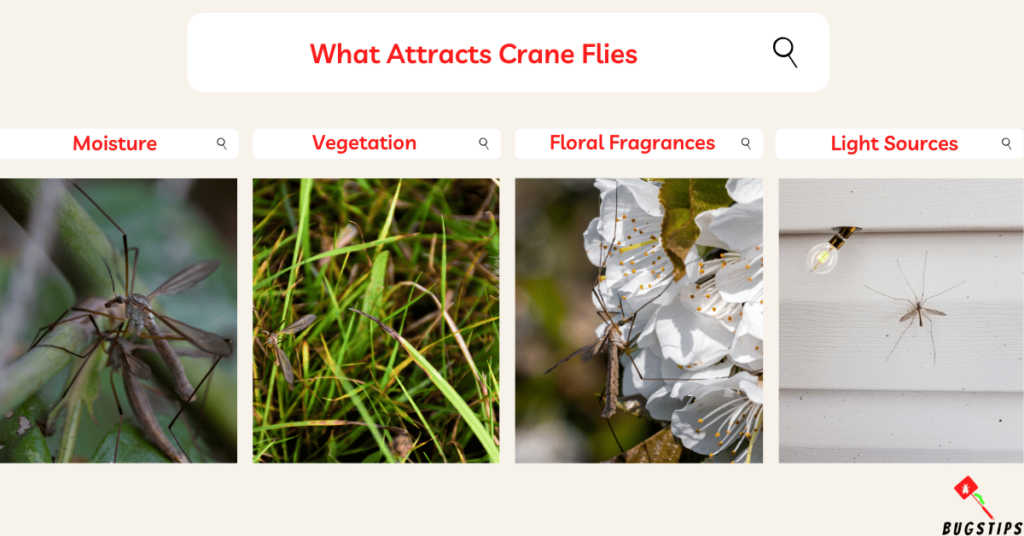
Here are some key factors that can cause an abundance of crane flies
Moisture
- Crane flies are attracted to moist environments, especially areas with damp soil or excessive moisture.
- Lawns that receive heavy irrigation or have poor drainage are more likely to harbor crane flies.
Organic Matter
- Crane fly larvae, known as leatherjackets, thrive in environments rich in organic matter.
- Lawns with excessive thatch or decomposing plant material provide ideal conditions for their development.
Shade
- Crane flies prefer shaded areas, as direct sunlight can be detrimental to their survival.
- Lawns with dense tree cover or areas with limited exposure to sunlight create favorable conditions for crane fly populations.
Lawn Care Practices
- Improper lawn care practices can contribute to an increase in crane flies.
- Overwatering, excessive use of fertilizers, and neglecting lawn maintenance, such as mowing and aeration, can create an environment conducive to crane fly breeding.
Nearby Water Sources
- If your property is located near bodies of water, such as ponds, streams, or lakes, you may experience a higher presence of crane flies.
- These insects are attracted to water sources for mating and egg-laying purposes.
It's important to keep in mind that while these factors can play a role in the presence of crane flies, the actual number of crane flies can vary depending on the region and specific environmental conditions. So, you may not always see a lot of crane flies even if the conditions are favorable for them. Conversely, you may see a lot of them even if the conditions are not ideal.
Related Article – 10 Long Skinny Black Bugs in House
Can Crane Flies Damage Lawns?
Crane flies have the potential to cause damage to lawns, particularly through the activities of their larvae. The larvae of European crane flies, in particular, can pose a threat to the health and appearance of turfgrass.
These larvae feed on various parts of the grass, including shoots, crowns, and roots, leading to significant damage, especially during the early spring season.
The feeding habits of crane fly larvae can result in visible consequences for lawns. Infestations often manifest as brown patches in the turf, indicating areas where the grass has been affected.
As the larvae continue to feed, the affected areas may experience thinning, and in severe cases, the entire lawn can be completely destroyed.
One notable thing of crane fly larvae is their movement across the soil surface as they search for more grass to consume. This crawling behavior can further contribute to the damage inflicted upon the lawn, as it allows the larvae to reach new areas and continue their feeding activity.
Related Article – Truth About Mosquito Eaters
Where Do Crane Flies Hide in the House?
Crane flies are primarily outdoor insects and do not typically seek shelter or hide inside houses.
However, it is not uncommon to find crane flies accidentally entering homes through open doors, windows, or other openings. Once inside, they may seek out areas that resemble their natural habitats.
Here are some common hiding places where crane flies may be found inside houses
- Windowsills
- Crane flies are often attracted to windows due to the presence of light.
- They may rest on windowsills or window frames during their brief stay indoors.
- Ceiling Corners
- Crane flies can be seen resting in the upper corners of rooms, particularly near ceilings.
- These areas provide them with a quiet spot away from human activity.
- Light Fixtures
- Light fixtures can attract crane flies, especially during the evening when artificial lights are turned on.
- They may be found near or on light fixtures, such as lamps or ceiling lights.
- Curtains and Drapes
- Crane flies may rest on curtains or drapes that are near windows or doors.
- The fabric can offer them a place to perch while they take a break from flying.
- Furniture
- Occasionally, crane flies may land on furniture, such as couches or chairs, particularly if these pieces are located near entry points or windows.
Related Article – 9 Types of Swimming Pool Bugs You Should Know About
Do Crane Flies Lay Eggs in Houses?
Crane flies usually don’t build nests or lay eggs inside houses because they are outdoor insects. They prefer to lay their eggs in moist soil or vegetation.
However, if the conditions inside a house are suitable, such as moist areas or organic matter, crane flies may lay their eggs inside.
But it’s rare for crane flies to lay eggs inside houses or infest them. Most of the time, if you see crane flies indoors, they accidentally entered the house and will leave on their own.
How to Get Rid of Crane Flies
If you’re looking to get rid of crane flies in your surroundings, there are several methods and products you can use.
Here we’ll explore each method and provide step-by-step instructions on how to use them effectively.
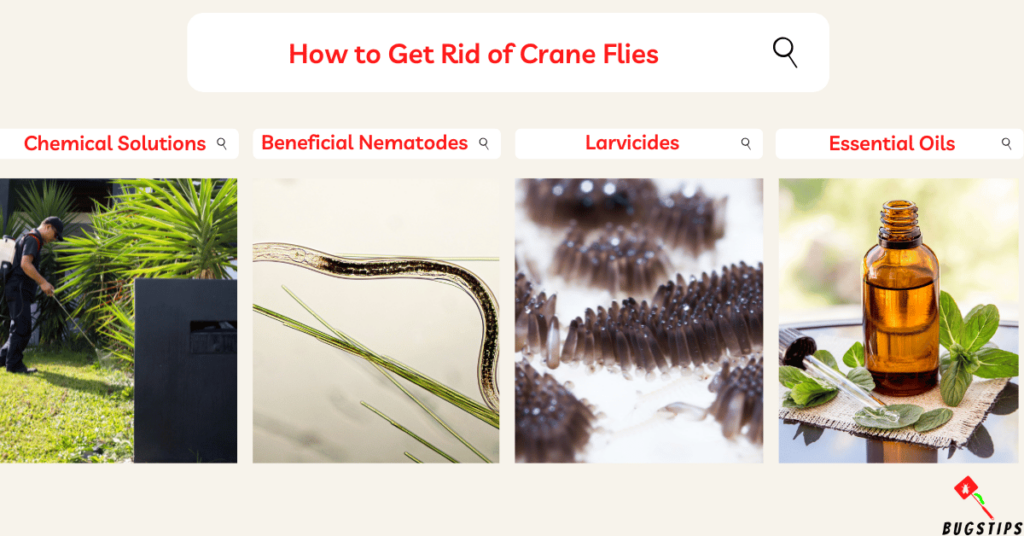
Ortho Dial N Spray Hose-End Spray
- This product is designed to be attached to a garden hose for convenient application.
- Fill the reservoir with the recommended amount of liquid weed and insect killer bug spray.
- Attach the sprayer to the hose and turn on the water.
- Thoroughly spray the affected areas of your lawn, paying close attention to moist or shaded areas where crane flies are likely to be present.
- Follow the manufacturer’s instructions regarding application frequency.
Beneficial Nematodes
- Beneficial nematodes are microscopic worms that prey on crane fly larvae in the soil.
- Purchase nematodes specifically formulated for controlling insects.
- Follow the package instructions to activate the nematodes by mixing them with water.
- Apply the nematode solution to the affected areas of your lawn using a sprayer or watering can.
- Make sure the soil is moist before application to facilitate the nematodes’ movement and activity.
- Repeat the application as recommended by the manufacturer, typically every few months or as needed.
Larvicides
Larvicides are effective tools designed to kill mosquito larvae before they have the chance to develop into adult mosquitoes.
While specifically formulated for mosquitoes, these larvicides can also be used to target crane fly larvae, preventing them from maturing into adult crane flies.
Follow these general steps:
- Read the instructions
- Carefully read and understand the manufacturer’s instructions provided on the product label.
- Pay attention to the recommended application rates, mixing instructions, and any safety precautions.
- Prepare the larvicide
- Prepare the larvicide according to the instructions.
- This may involve diluting a concentrated solution, mixing granules with water, or using a pre-mixed formulation.
- Apply the larvicide
- Apply the larvicide to the target areas where crane fly larvae are present or likely to develop.
- Use the appropriate application method, such as spraying, spreading granules, or placing briquettes, as recommended by the product instructions.
Bug Zappers
- Bug zappers can be effective in attracting and killing flying insects, including crane flies.
- Place the bug zapper in an area where crane flies are commonly seen, such as near outdoor seating areas or near light sources.
- Ensure that the bug zapper is positioned away from areas where people gather to avoid unnecessary disturbances.
Keep in mind that bug zappers provide temporary relief and may not eliminate the root cause of the crane fly problem.
Hanging Fly Traps
- Hanging fly traps are designed to attract and trap flying insects.
- Hang the fly trap in an area with high crane fly activity, such as near windows or doors.
- Follow the manufacturer’s instructions for assembling and positioning the trap.
- Monitor and replace the trap as needed, especially when it becomes full or loses its effectiveness.
Flying Insect Glue Ribbons
- Flying insect glue ribbons are sticky traps that can be hung to catch crane flies and other flying insects.
- Hang the glue ribbons in areas where crane flies are frequently observed, such as near windows or light fixtures.
- Replace the ribbons when they become covered in insects or lose their stickiness.
Essential Oils
- Mix a few drops of peppermint or lavender essential oil with water in a spray bottle.
- Shake the bottle to ensure the oil is well-distributed in the water.
- Spray the solution in areas where crane flies are present or likely to hide, such as corners of rooms or near windows.
- The strong scent of these essential oils may repel crane flies.

Vinegar Trap
- Create a vinegar trap by filling a shallow dish or bowl with equal parts water and white vinegar.
- Add a few drops of liquid dish soap to the mixture and stir gently.
- Place the trap in areas where crane fly larvae are commonly found, such as damp or shaded spots in your lawn or garden.
- The vinegar scent attracts the larvae, and when they come into contact with the solution, the soap breaks the surface tension, causing them to drown.
- Check the trap regularly and empty and refill it as needed.
Dish Soap and Insecticidal Soap
- Create a solution by mixing dish soap or insecticidal soap with water in a spray bottle.
- Spray the solution directly on crane flies to kill them on contact.
- Additionally, you can spray the solution on areas where crane flies rest or congregate, such as windowsills or walls.
- Repeat the application as necessary.
Home Remedies (Garlic, Neem Oil, and Citronella)
- Crush several garlic cloves and mix them with water in a spray bottle.
- Shake the bottle well and spray the garlic solution in areas where crane flies are active or likely to hide.
- Neem oil can also be mixed with water and sprayed onto affected areas to repel crane flies.
- Citronella candles or citronella oil can be used outdoors to deter crane flies from gathering near outdoor spaces.
Manual Methods
- Use a fly swatter to manually eliminate crane flies when you spot them indoors.
- Approach the crane fly slowly and carefully to avoid startling it.
- Gently and swiftly swat the fly with the swatter, aiming to strike it mid-flight.
- Fly killers, such as handheld devices or electric swatters, can also be used for more effective and hygienic fly elimination.
While there are various methods available to control crane flies, manual methods like fly swatters and fly killers offer a more hands-on approach.
Remember to combine different methods for the best results, as some approaches may be more effective in specific situations or environments.
How to Prevent Crane Flies
Preventing crane fly populations from growing is the best way to manage them. By taking proactive measures, you can significantly reduce the chances of having a crane fly infestation.
Here are some effective strategies you can implement to prevent crane flies from taking over your lawn or home.
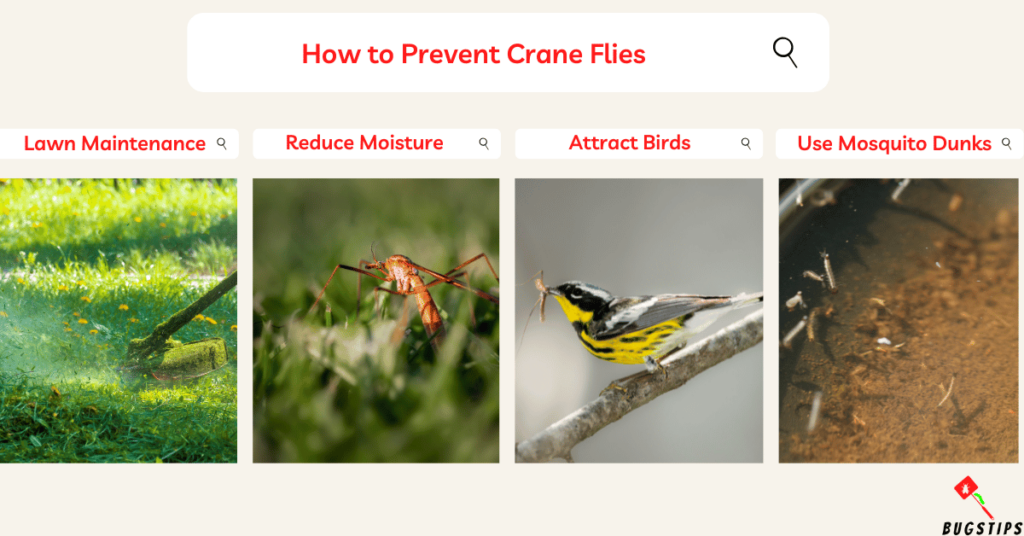
Lawn Maintenance
- Regularly mow your lawn to keep it at a healthy height.
- Crane flies prefer longer grass, so maintaining a shorter turf can deter them.
- Remove any excessive thatch buildup, as it can provide a suitable habitat for crane fly larvae.
Reduce Excess Moisture
- Ensure proper drainage in your yard to prevent the accumulation of standing water.
- Remove any sources of excess moisture, such as areas prone to puddling or poor irrigation practices.
- Avoid overwatering your lawn, as excessive moisture can create favorable conditions for crane flies.
- Water deeply and infrequently, allowing the soil to dry out between watering sessions.
- Consider using mosquito dunks or larvicides specifically designed for mosquito control in water features like ponds or fountains to prevent crane flies from laying their eggs.
Outdoor Lighting Considerations
- Adjust your outdoor lighting to minimize attraction to crane flies.
- Consider using yellow or sodium vapor bulbs, as they are less appealing to insects compared to traditional white lights.
- Position lights away from entrances to your home to prevent attracting crane flies indoors.
Natural Predators
- Attract natural predators of crane flies, such as birds, to your yard. Provide bird feeders, birdhouses, or birdbaths to encourage their presence.
- Birds will naturally feed on crane flies and help control their population.
Physical Barriers
- Install fine mesh screens on windows, doors, and vents to prevent crane flies from entering your home.
- Make sure the screens are in good condition and free from any gaps or tears.
By following these preventive measures, you can make your surroundings less inviting to crane flies, which reduces the risk of infestations in your home and outdoor spaces. Implementing a combination of these strategies will significantly improve your chances of keeping crane flies away.
So, be sure to try out a few of these methods and see which ones work best for you.
You May Also Like – Little Black Bugs in My Car | Expert Removal Guide
Final Thoughts
While crane flies may not be harmful to humans, they can be a nuisance and cause damage to lawns. Fortunately, there are several effective ways to get rid of them, including using commercial insecticides, natural remedies, and manual methods.
Additionally, implementing preventative measures like reducing moisture and vegetation in your surroundings can significantly reduce the likelihood of crane fly infestations.
By following the strategies outlined in this article, you can effectively manage crane fly populations and enjoy a pest-free home and lawn.
Remember, it’s important to choose the method that works best for you and your specific situation. Don’t be afraid to try out different methods until you find the one that works best.
We hope this article has provided you with the information you need to successfully get rid of crane flies and keep them from coming back.
FAQs
How long is crane fly season?
Crane fly season typically spans from early spring to fall, depending on the region and environmental conditions.
Can crane flies hurt you?
No, crane flies are harmless to humans. They do not bite or sting.
Why do crane flies fly at your face?
Crane flies are attracted to light sources, and their erratic flight patterns may cause them to fly near your face. They are not intentionally targeting humans.
How long do crane flies live in the house?
Crane flies have a relatively short lifespan, typically ranging from a few days to a few weeks. If they find their way indoors, their lifespan may be shortened due to limited access to food and suitable habitats.
What birds eat crane flies?
Birds such as swallows, starlings, sparrows, and robins are known to feed on crane flies, helping to naturally control their populations.
Do bug zappers work on crane flies?
Bug zappers can provide temporary relief by attracting and killing various flying insects, including crane flies. However, their effectiveness in controlling crane fly populations in the long term may be limited.
Does citronella repel crane flies?
Citronella is commonly used as an insect repellent. It may have some deterrent effect, but additional control measures may be necessary for effective crane fly management.
Resources – (for further reading)
The Oregon State University – Managing Crane Fly in Lawns | OSU Extension Catalog
UC ANR – Crane Flies / Turfgrass / Agriculture – UC IPM
The Michigan State University – Cranefly – Integrated Pest Management


